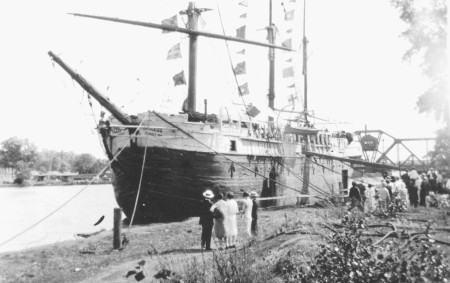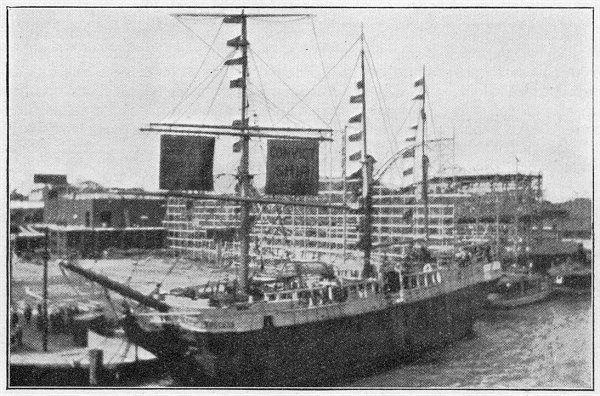The SUCCESS - convict ship

Photo: collection Great Lakes, Naval Marine Archive, circa 1936
The SUCCESS, 117'3" x 26'8" x 22'5", 621 tons, launched 1840 [1] (a launch date of 1790 has been suggested, we believe in error; most likely a promotional gimmick, it gained credibility from an article a few years later, 1924, in Sea Breezes magazine - see below [2]) at Natmoo, near Moulmein, Burma for Cockerell & Co. of Calcutta, or various of her directors, for the Indian 'country trade'. After voyages in many trades, she became a prison hulk in Australia; she was used as an exhibition ship in Australia, England, Ireland and the Great Lakes; her career ended when she burned at Port Clinton, 4th July, 1946.
From The Mariner's Mirror, Volume VI, p218, 1920
AN AGE COMPETITION.
The information on centenarian sea-going vessels which has appeared under the above title in several issues of the "M. M." from vol. i., p. 152, onwards, has been referred to in The Nautical Magazine for June, 1919, on p. 529, and this notice has elicited a communication which appeared in the December, 1919, number of the same journal (p. 572). The writer, Mr. A. T. Saunders, give additional particulars of most of the vessels in ths list on p. 152, vol. i., of the "M. M.", and he deals at length with the common misconceptions as to the "convict ship" Success, of which the most important are that she dated from the XVIIIth century and that she was employed in the carriage of "transports" from England to Australia. His account of her, which is evidently written with local knowledge, contains the following outstanding statements regarding this famous veteran. She was not built at Pegu in 1787, as is sometimes stated, but at Moulmein, Burma, in 1840; and she appeared in Lloyd's Register, 1849, as no. 683, 621 tons register, classed 12 A1. Between 1843 and 1852 she made several voyages between Australia and England as a passenger and emigrant ship. In the latter year she was one of five vessels (The President, Deborah, Lysander, and Sacramento being the others) taken over by the Victorian Government for the custody of prisoners when the Gold Rush of 1851 greatly increased the criminal population. In 1858 her convicts were removed to a gaol on land, and she became a lock-up for refractory sailors. In 1891 she "was bought by a syndicate which christened her a convict hulk, fitted her up with wax figures, and invented great age and a lurid past for her" (hence possibly the legend of her being built as far back as 1787). After an Australian tour she sailed for England, and made Dungeness on I2th September, 1895, 166 days out from The Semaphore, S. Australia, under Captain Allen: and I daresay that many members of the Society besides myself visited her and saw the wax figures of transports in their cells during her stay in the Thames. Mr. Saunders concludes his account of her by alluding to another mistake which has passed into history, viz., that she was identical with H.M.S. Success, which was in Australian waters in 1829, and which I find was a 6th rate of 28 guns, launched at Pembroke in 1825 and taken to pieces in 1849. Her visit to Australia identified her subsequently so firmly with the prison hulk Success that "The Western Australian Year Book" for 1902-4 contained an illustration of the latter labelled "H.M.S. Success," the same title was affixed to a photograph of the prison hulk as rigged for her voyage to England in 1894, which was hung in the Perth Public Library. An illustrated pamphlet on the prison hulk, published at Perth, perpetuated the error. Fortunately, Mr. Saunders was able to demolish the legend on the spot. He mentions further that the "South Australian Register," for 15th May, 1918, quoted from an American paper that "the famous old English convict ship had been wrecked at Carroll Town, Kentucky, and had sunk in 50 feet of water in the Mississippi." Can any member confirm this statement, which makes the career of the Success 78 years ? I have heard somewhere that she sailed to the United States after being "on tour" in British waters. Presumably, full-rigged in her early days, I think she was a bark when moored in the Thames.
The article below is from Sea Breezes, The P.S.N.C. Magazine, No. 63 Vol. VII, February 1925, p. 111-112 :
A Survivor of the East Indiamen
When discussing old craft still afloat there is one which appears to be missed, that is the Success. Built in 1790 at Moulmein this old ship probably has a better claim than any other to be considered the most ancient vessel now afloat. Probably also she is the sole survivor of those India-built ships which were so popular in an earlier day. The secret of her long life, of course, is based upon the fact that she was constructed throughout of good, solid Burmese teak, which, for resistance to wind and weather and the usual effects of time, has no equal in the world.
Now little more than a hulk.
Though she has now degenerated to the position of an exhibition ship, visiting different parts of the world to show how convicts were treated in the days when Australia was little more than a penal settlement, the Success was one of the great East Indiamen of her day. As is usual for that service she was built more on the lines of a man-of-war than a merchant ship, was heavily armed and prepared to resist attacks from either pirates or the King's enemies. Her other fittings were on a par in magnificence with the rest of the East India ships, and she carried many passengers of note both on her outward and homeward voyages.
The dimensions of the ship are - length 135 feet, beam 30 feet, and her tonnage is given as 1,100, so she was quite a big ship for her day. As an example of the strength of the vessel it may be mentioned that at the bilge her sides are 2 feet 6 inches thick, whilst her keelsons are of enormous dimensions. Like the rest of the East India ships she was never distinguished for speed, her bluff bows, square heavy stern, and quarter galleries show that strength and not speed was the main principle of her builders.
As she appeared in brighter days.
However, what was lacking in speed was made up in ornamentation, the quarter galleries being decorated with highly elaborate carving, whilst her stern carried the usual ornate gilded scroll work common to ships of the Anglo-Indian fleet. A description of this vessel would be incomplete without reference to the figurehead, which is a magnificent example of wood carving. As usual, it consists of the figure of a woman with outstretched arm pointing the way. The old craftsman who worked on this evidently enjoyed the task, and made of it almost a living thing.
Of her service on the Indian run there is not so very much to say, though she had the usual outbursts of excitement which are inseparable from the sighting of suspicious vessels, and on one or two occasions actually had engagements with pirate craft. Thus the Success had what might be regarded as a pleasant existence until the year 1802, when she was chartered by the British Government to transport convicts to Australia. At that period even the smallest offences were treated with great severity and, for such as now would only merit the punishment of a small fine, offenders were sentenced to a period of seven or more years in jail or transportation. Of the time spent in this service the least said the better.
This, however, was not the most tragic phase of the existence of the Success, for though she continued to carry convicts to Australia until 1851, in that year she was permanently stationed as a receiving prison in Hobson's Bay. Her passenger accommodation gave place to heavy cells.
constructed in the 'tween deck and orlop decks. By 1857 the disclosures which had been made in connection with the treatment of prisoners resulted in the abandonment of the hulk system, and for some years later the Success was used as a reformatory ship, until the order was given that all prison hulks were to be sold on condition that they were broken up. By a clerical error, however, that particular clause did not appear on the terms of sale of the Success, hence she remains the only British convict ship in the world to survive.
In 1885 the old ship sank in Sydney harbour, and remained at the bottom of Fort Jackson for five years, being raised and fitted out as an exhibition ship. In the course of her wanderings she has been taken round the coast not only of the Australian colonies, but twice around the British Isles, and is now on show in America.

Another view of the Success.
It seems a pity that this ship should serve such an ignoble purpose.
A remarkable feat.
In 1912 it was decided to attempt what was possibly the most remarkable feat in all her remarkable career, that is, to make a voyage across the Atlantic under sail only and unaccompanied by any escort. The project was then declared to be impossible, for no one, save those with special information as to the condition and construction of the ship, could believe that a vessel over 120 years old could possibly make the passage.
However, she was prepared for the trip and left Glasson Dock, near Lancaster, bound for Boston. The passage proved a very stormy and eventful one, but nevertheless, the Success exemplified her name by reaching Boston harbour, where she was received with great enthusiasm by the press and public alike. Following a tour of all ports of the Eastern sea-hoard, she was taken through the Panama Canal to be exhibited in San Francisco during the Panama-Pacific Exposition, and after a tour of the Pacific coast, made the rounds of the great rivers of America, and is now in the Great Lakes.
